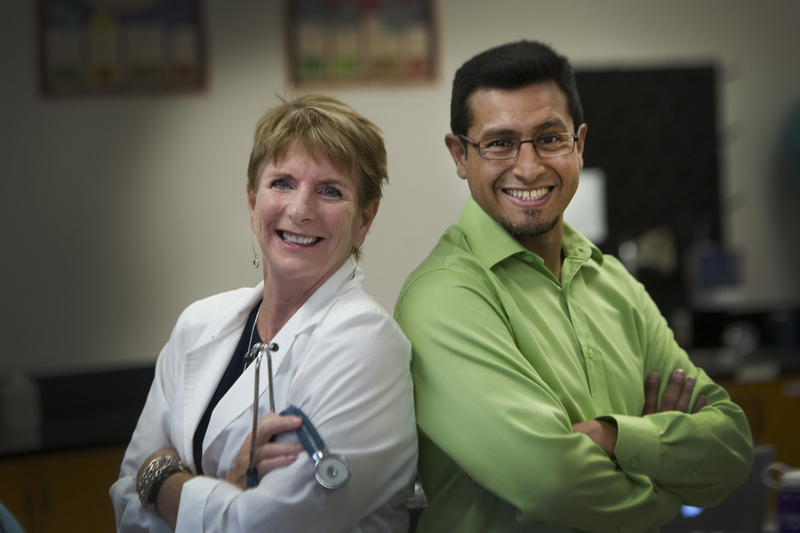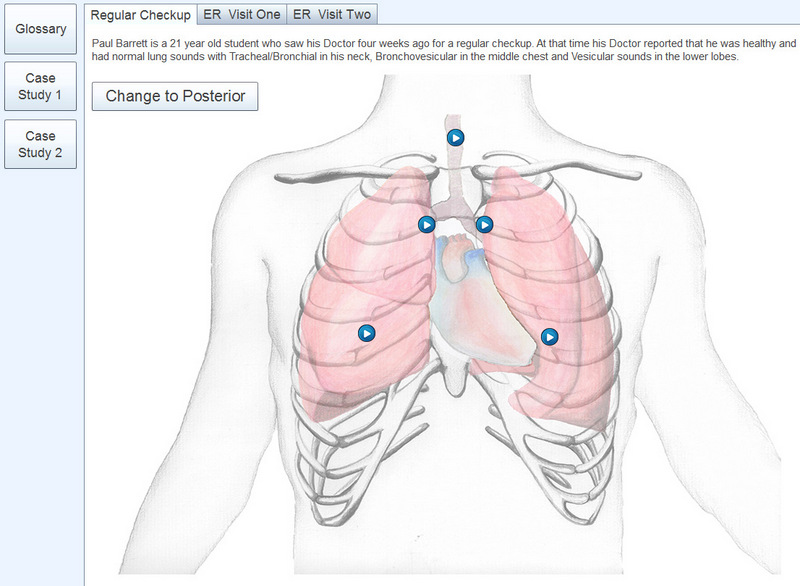Computer scientists and nurses pair up to create teaching software

 Although many techniques for evaluating a patient’s lung condition exist, listening to the sounds their lungs make remains an invaluable clinical tool for medical practitioners. In fact, it’s probably the most common method for evaluating the condition of a lung.
Although many techniques for evaluating a patient’s lung condition exist, listening to the sounds their lungs make remains an invaluable clinical tool for medical practitioners. In fact, it’s probably the most common method for evaluating the condition of a lung.
For the past six years, Dr. Oscar Meruvia-Pastor, an assistant professor cross-appointed between the Department of Computer Science and the Faculty of Science’s Office of the Dean, has been working on a project to assist nursing students with learning this vital procedure.
It started when Dr. Karen Andres, a registered nurse (RN) currently at Alberta’s South Health Campus, approached him when they were both teaching at Thompson Rivers University in Kamloops, B.C.
“She was a faculty member in the School of Nursing and came to me wondering if we could make multimedia software for nursing students to teach them how to interpret breath sounds,” he said. “We received seed funding from Thompson Rivers University to begin looking into it, and shortly after that, I came to Memorial.”
Despite the distance, the pair continued to work together and brought in Dr. Creina Twomey, a RN and assistant professor with the School of Nursing at Memorial.
Together, the nurses developed narratives for a series of case studies, which provide the core of the multimedia experience, including descriptions of the relevant data ― measurements such as pulse, temperature and respiratory rate ― needed for patient evaluation. Dr. Meruvia-Pastor and his research assistant, Pranjal Patra, developed an online multimedia assessment of respiratory conditions (OMARC) to tie it all together.
OMARC simulates what happens when a person visits a hospital and is observed by a nurse for the purpose of health assessment to see if their breathing is normal or abnormal. Students are expected to identify and interpret a glossary of sounds associated with lung health.
“If you have a textbook, they will have a description of the sounds, but it’s not the same as actually hearing them,” said Dr. Meruvia-Pastor. “That’s why some textbooks will come with a CD. This software provides the students with relevant information that will let them learn the sounds, associate the sounds with a location on the thorax and comprehend the contexts within which sounds may appear so they can identify them later on.”
 After the software was developed, the team began a user study to see how much it will improve students' learning by inviting Memorial’s nursing students for a test drive.
After the software was developed, the team began a user study to see how much it will improve students' learning by inviting Memorial’s nursing students for a test drive.
“We wanted to know whether students would like it or benefit from it,” said Dr. Meruvia-Pastor. “We evaluated students on their ability to identify the sounds before they used OMARC and after, and we had really good results. The students' ability to identify the sounds significantly increased after using the software. In addition, the students found the software very useful, were excited about it, and said they would recommend it to other students.”
After the first successful user study, the team attempted a second study, but were unable to get enough students to participate to form a statistically significant conclusion.
“It was done on a volunteer basis at the end of a semester when students were busy,” said Dr. Meruvia-Pastor. “It was disappointing because we had prepared for 40 people and only got one. So we couldn’t report on that second study. But I’m hoping to try again in September.”
While the team believes the software could greatly benefit nursing students who are in the process of learning how to distinguish breath sounds, they feel it could also have other uses. For instance, nurses could use it as a training refresher. The software is currently a prototype, but the long-term goal is to make it accessible online, so anyone can use it anywhere — a particularly relevant benefit in rural settings where large facilities or populations are not present.
Before making the software publicly available, though, the team intends to replace the current breath sounds used in the program.
“At the moment we can only use the sounds in the software for the research and academic purposes because we don’t own the sounds. We have licensed them under certain restrictions, which prevents us from putting the software online. If we want to make it public we would have to either replace the sounds or sign a new agreement with the original owner.”
In the meantime, with the lead of Dr. Meruvia-Pastor, the research team has submitted an article for journal publication describing the results of the first trial, which is currently in the review process.